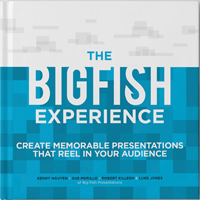Four Public Speaking Resolutions Every Presenter Should Make in 2017

We’re a bunch of goal junkies at Big Fish Presentations/ThreeSixtyEight. However, we’re realists in that we can only focus on so many goals. For 2017, we’d like to challenge our clients, readers, and friends on becoming the best presenters they can be. Instead of creating a long list of resolutions for 2017, we narrowed our focus to just four . If you’re able to accomplish and learn how to do these four resolutions well, we guarantee the impact your presentations deliver will drastically improve. Heck, if you learn how to incorporate one of these practices in your presentation process, you’ll still see results (as we know the readers of the Big Fish blog though are all over achievers, we’d like to think you’ll do all four!).
Here are the four presentation resolutions we recommend every presenter should make in 2017:
-
Rehearse a minimum of 3 times before you deliver your presentation:
When rehearsing your presentation, rehearse in front of an audience or in front of a camera to watch yourself.
Criteria to judge yourself on include:
- Purpose– If you were in the audience’s shoes, is it easy to watch yourself and understand what you are asking for?
- Jargon – Are you using words or acronyms that can be confusing to the audience?
- Pace– Are you speaking too fast where it’s hard to understand? Can you pause at certain points to help emphasize points?
- Flow– Do you tend to ramble and go on a tangent in certain parts of your presentation?
- Body Language – Are you doing anything that is distracting to the audience? Are you able to keep your legs positioned shoulder-width, arms open, and hands moving with a smile?
- Reliability: Can you present this presentation without a presentation? If AV ever crashes on you, will you be ready?
-
Simplify your points and data:
It’s very important to deliver stats that are relatable to the audience. The example we love to use is when Steve Jobs stated, “The Apple iPod has 10GB and that’s 2,000 songs.” This is a basic example of how data should be delivered. Presenters should consider their audience’s needs, and deliver the stats in a way the average person can apply the information. This will help the audience consume the data points in a more impactful way.
- Showcasing a compare and contrast stat such as, “In 2015, the top performing trailers from each nominee have collectively been watched over 200 million minutes on YouTube —that’s over 3.3 million hours, or the equivalent of nearly a million Oscar telecasts.”
- Or a decreasing value size vs. an increasing value size such as “This will cost 4 trillion dollars to execute, or 11 billion dollars a day.” This provides association points to showcase the scope of the number.
- Bonus takeaway:When a presentation requires you to showcase a lot of data on slides, organize your slides to ONE graph to be the main focus per slide. You can either break down the chart-heavy graphs into multiple slides or feature a transition that can unveil graphs as you talk about it through clicks.
-
Create powerful calls to actions in every presentation:
Segment your points into a structure an audience can follow along with while also including a call to action that can move the audience. Without a call to action, there is no strong action the audience feels that they need to take. There are three different types of call to actions that include: the ask, question, or demand. You can read more upon those three here.
-
Always, always create a Big Idea for a presentation:
Before even considering design or delivery rehearsal, always establish a big idea for your presentation. A big idea is your central argument or theme of your entire presentation. It should be something that others really care about. Encourage your team to be able to state their big idea in concrete, but simplistic terms. You can read more building big ideas for presentations here.
In order to create great presentations, it obviously takes practice. You know that. However, organize the above points into a process that you can easily adopt into habits. For example, why don’t you create a checklist you always follow before you give a presentation? It can look something like:
Myself and my presentation are ready to be delivered when:
- I can deliver my presentation without the slideshow
- I have rehearsed a minimum of three times
- I can simplify any data point in the presentation that may be confusing into something simple and relatable to the audience
- I know exactly what I am looking for my audience to do through my call to action
- I know exactly in one sentence the main argument I’d like my audience to remember about my presentation.
While it doesn’t have to look exactly like the above checklist, having a great mental note or print out near your desk right before your next presentation can make a world of difference.
We hope you enjoyed this post and make 2017 your best year as a speaker yet! For more info and future posts on how you can be a better speaker, please subscribe to our blog. Happy New Year!




Share your opinion.